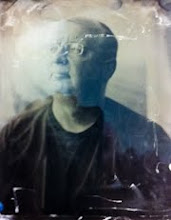Title: "Contemplating non-existence"
(click image to view larger)
I had an odd e-mail exchange with a friend, let's call him "ALEX*" (*not his real name). He sent me and a another friend this e-mail:
--------------
Hello Gentlemen Photographers,
I have been meaning to send these out.
I lovingly shot these fine portraits one evening when I was otherwise unengaged. The images are the result of long exposures and movement. No digital trickery was used, and all effects were achieved "in camera". What a fine looking family!
Cheers..... "ALEX*"
I have been meaning to send these out.
I lovingly shot these fine portraits one evening when I was otherwise unengaged. The images are the result of long exposures and movement. No digital trickery was used, and all effects were achieved "in camera". What a fine looking family!
Cheers..... "ALEX*"
--------------
Now, the problem was, there were no images with this message. "ALEX*" (*not his real name) is not above spoofing people from time to time, and what with him being a bona fide art school graduate, I thought he was doing a little spoofing in the best pomo traditions. So I responded "in kind", showering his "work" some of my most favourite empty-headed, meaningless flickr-type comments "awesome", "nice bokeh", etc. "ALEX*" (*not his real name), replied the next morning a little peeved with my smart-aleck response, with the actual images attached. Indeed, a fine looking family of people they were, too (and one was a cat, although it looked like some wild beast from the underground!).
I mention this because the original e-mail, with its minimalistic description of the "non-existent" images, reminded me of numerous times I've read reviews of exhibitions, or a discussion of an artist's many years of work in art magazines. It seems that there is a policy about these types of articles that states: "whatever you do, don't discuss the art shown in the two illustrations accompanying your article". Indeed, these articles are famous (at least to me) for going on ad nauseum critiquing or gushing about work that isn't actually shown in the magazine.
Which, in a very round-about way brings me back to Fairbairn's statement I talked about a couple of days ago, "Whereas art is unthinkable in the absence of either the artist or the work of art, there is at least no theoretical difficulty in conceiving of art in the absence of an audience". My question is this: is there an audience if the art work is only described, but not viewed? Can we appreciate art third-hand? In a way, it's an interesting exercise to first hear a description of a work, picture it in your mind from that description, and then view the actual work. It illustrates perfectly how inadequate a verbal description of a visual image typically is, which makes it interesting that we endeavour to discuss art. Perhaps the difficulty in verbally thinking about art explains why an entire, seemingly arcane vocabulary can and was constructed for use in critiquing art.


1 comment:
I completely agree with your comment that words aren't adequate to describe visual art. By definition, words and pictures are just not the same thing. If they were, we might put the word "landscape" in a frame on our wall! It seems to me that maybe it would make more sense for us to try to describe our responses to art rather than discussing the art itself, since language is one tool we have to express our internal experiences.
Post a Comment